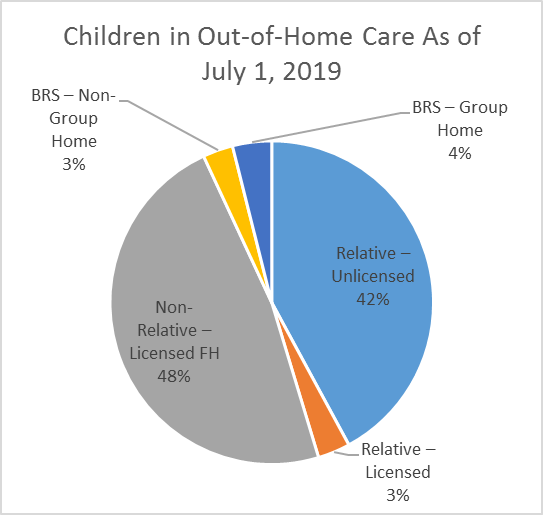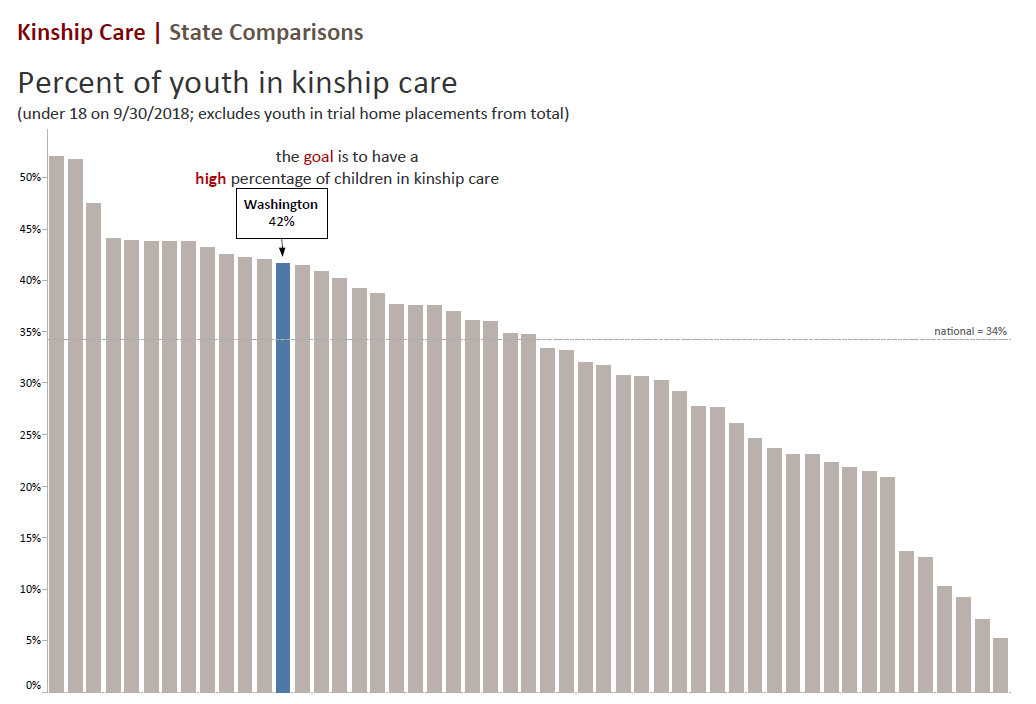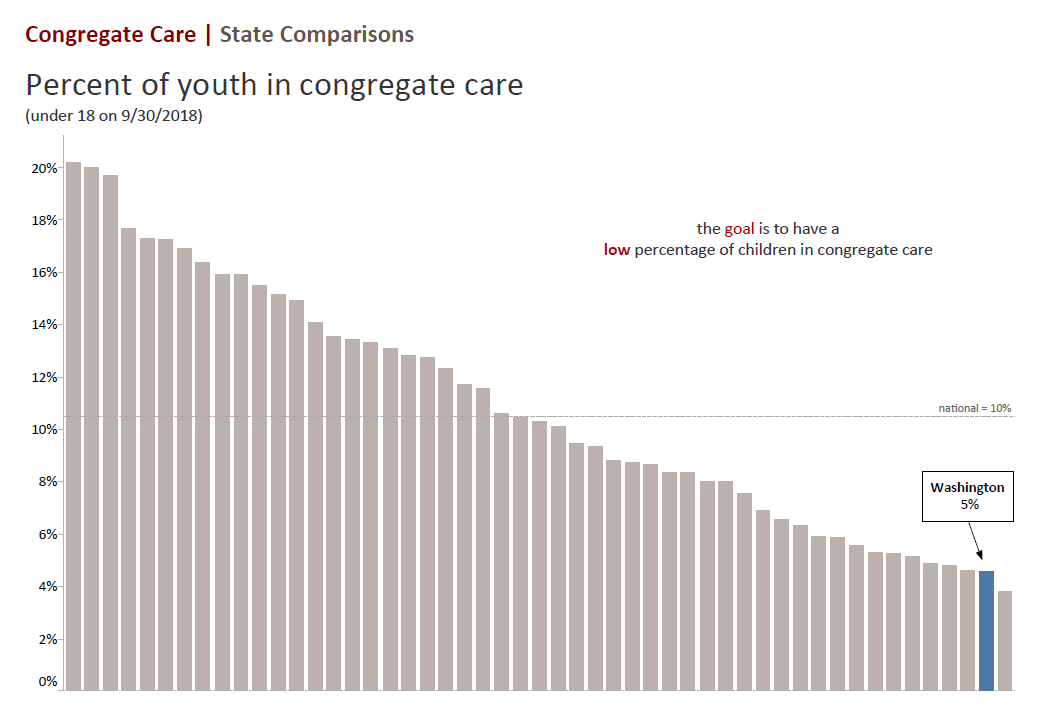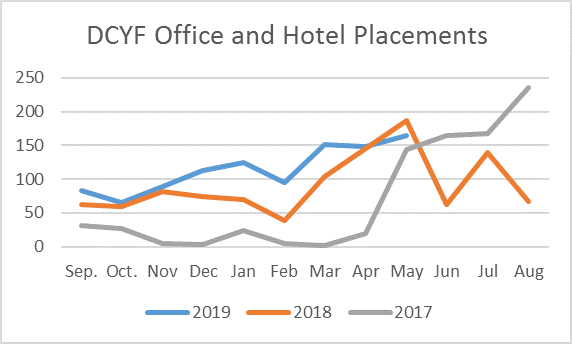One of the biggest problems our child welfare system has is how to care for children who are severely traumatized and have mental health or physical issues that make it difficult for a typical foster family to care for them. We don’t have enough “beds” in therapeutic group homes for the children who need that level of care, resulting in many pathologies in the system.
- We have an escalating number of nights when children stay in one of our offices or in a hotel. There were 824 hotel stays in 2017, 1,090 in 2018, and 1,035 so far this year, with five months to go.[1]
- Out of state placements. In August of last year, we had 82 youth placed in out of state group homes. It is difficult to safely supervise their placement there, it costs more, and it is difficult for the youth to transfer back to Washington for a more permanent placement. (With focused attention we reduced this to 38 as of July 1, with more to go.)
- Turnover is particularly high in offices that have a lot of office and hotel stays. Experienced caseworkers do much higher quality social work. Too much turnover also creates overwork scenarios because new workers can’t handle as large a workload – everyone else has to pick up the slack.
There are typically about 9,000 children/youth in what we call “out-of-home-care” at any one time. Classic “foster care” is one of the possible placements for these children, but there are others as well.
Kin/Appropriate Other placements are exactly that – state and federal law requires us t o prioritize placement with family or people who are well known to the child. State law provides little compensation or financial support for these placements unless they are licensed. In some cases, the court will place a child in one of these situations when we have denied a background check due to something the court considers less important than the familiarity for the child.
o prioritize placement with family or people who are well known to the child. State law provides little compensation or financial support for these placements unless they are licensed. In some cases, the court will place a child in one of these situations when we have denied a background check due to something the court considers less important than the familiarity for the child.
Foster care. DCYF licenses people to be foster parents. There is financial support for foster placements that averages about $700 per month per child. Foster homes are not allowed to have more than 6 children in their home unless there are exceptions made for large sibling groups.
Treatment Foster Homes. Some children have extensive therapeutic needs and are placed in specially trained foster homes with extra support brought in to help manage the child or provide care for a medically-fragile child. This is part of our Behavioral Rehabilitation Services (BRS) system. This is BRS non-group home in the chart.
Group homes. A small number of children have behavioral concerns or therapeutic needs that cannot be met safely in a therapeutic family home and are placed in specialized facility-based programs that provide support until the child is healthy enough for a more typical placement. This is what people think about when they talk about BRS.
Washington is unique in several ways. We place a high percentage of children with family or appropriate others compared to other states – about 42% in this comparison. This is usually great for the child as they already know the family, but it can put an incredible strain on the finances of already low-income families.

We also place a very low percentage of our children in out of home care in group homes compared to the rest of the nation. About 5% of children in out of home care in Washington are in group homes, compared to about 10% nationally. Most research into child outcomes supports keeping children in the least restrictive placement possible – it is better for the child in many ways.

Unfortunately, our standout position in national rankings here isn’t necessarily due to good management – the rates we pay to these providers don’t cover the costs of providing the service[2] and we have experienced declining supply since rates were largely frozen in the 2009-11 budget due to the recession. Unfortunately, a lack of BRS group home beds does not reduce the number of children who need them.
The lack of available placement options for children with extensive psychological or behavioral needs has resulted in a number of bad outcomes:
- In August of 2018 there were 82 children placed in out of state facilities similar to
 instate BRS facilities. This is more expensive and is more difficult to monitor. The distance from home is likely to make it harder to return home or find a permanent placement.
instate BRS facilities. This is more expensive and is more difficult to monitor. The distance from home is likely to make it harder to return home or find a permanent placement. - Children needing a BRS placement have experienced increasing numbers of overnight stays in DCYF offices or hotel rooms due to lack of placement options. OFCO measures this from September 1 to August 31 of each year. As of May 31, 2019, there have been 1,035 office or hotel stays. This compares to 1,090 for all of the previous year.[3]
- In some regions the only available placement options are single-night placements, often at significant cost. These foster homes will accept a child late at night and require the child to be picked up before breakfast. This is cruel and we will attempt to eliminate the practice.
The low rates paid to BRS providers also reduces the quality of the service. The rate study reported an average turnover rate of 45% for these facilities. This average hides truly horrifying turnover rates close to 60% for staff providing direct care to clients. Providing quality care to incredibly traumatized children requires a level of training that is not consistent with this kind of turnover.
In addition, the way DCYF contracts with these providers results in many placement disruptions for children in BRS facilities. In general, we aim for stability in placements for children as it results in less trauma over time.
New Federal and Legislative Regulations
The external situation for DCYF has new options as a result of changes at the federal level and changes to requirements in the bill creating the agency.
The Family First Prevention Services Act (FFPSA) is Congress’ first major change in the way federal funds for foster care are delivered in decades. It makes extensive changes to DCYF’s financial world that have been covered elsewhere. The interesting part for BRS is the creation of the new Qualified Residential Treatment Facility (QRTP) standard. In order to use federal funds to support these placements we are required to have providers become much more therapeutic than they have historically been funded to be.
The Legislature requires all of DCYF’s client services contracts to meet a “performance-based contracting” standard. This means that there need to be performance metrics built into the contracts we have with providers. These should be linked to improvements in outcomes for children.
In 2018 the Legislature also returned BRS to the budget forecast. This means that if more children qualify for the service the budget will be automatically adjusted to match the new demand.
In 2019, in response to the rate study, the Legislature funded an increase in rates of close to 45% for the main category of providers. This covers the cost of complying with the minimum wage standard, but not all of the new QRTP requirements.
What Does “Winning” Mean?
When we think about an area of practice it’s important to “keep the end in mind” as Steven Covey would have said. We want children and youth who are placed in group home facilities that are intended to be therapeutic to actually get better. We have a couple of ways of looking at that, and are working through these issues as we work out our performance-based contracting plan.
First, if the child is getting better, they will be able to be in less restrictive placements. We should see less time for individual children in group homes and more in step-down placements. Fewer placement changes will lessen the time children are in care, and more of them will reunify with their birth family or have another permanent family.
We also want to look at the impact on the entire system of our changes. If the rates are adequate, we should see more beds available for children needing one so we are not desperate and have kids in hotels or offices. The cost of placements should be less variable as there is less demand for limited placement options. Placements overall should be in closer proximity to the birth family, resulting in more visitation and faster and more frequent reunification.
Agency Actions
DCYF will take the following actions to meet these success criteria.
Rate Increase Effective 10/1/19
DCYF engaged Public Consulting Group (PCG) to conduct a cost study of BRS services. This work resulted in recommendations for significant increases in rates paid to BRS providers. DCYF also changed from assigning rates based on acuity of the child to paying rates based upon the setting the youth is in. DCYF lacked a comprehensive way to assess acuity and discovered through the cost study that the differences in costs for youth is really driven by the different type of settings rather than acuity. DCYF worked with BRS providers to develop compromise rates that fit within the funding provided and largely reflected the work of the cost study.
The rates are designed so that providers can break even if they have 80% capacity. It’s not reasonable to assume they are 100% full all of the time and we want to have some slack in the system so that we always have available slots for emergency placement needs.
Performance-Based Contract Requirements
In the new BRS contracts we established a 90% acceptance rate target. Contractor performance will be tracked over the coming year to ensure the target is reasonable and doesn’t negatively impact BRS providers or clients prior to holding contractors accountable for reaching the target in future contract cycles.
Of course, all the providers are required to meet the requirements for being a “Qualified Residential Treatment Facility” so that we can qualify to use federal funds, a key element of the rate increase feasibility. These include:
- Accreditation
- Use of a trauma-informed treatment model
- Specific nursing and staffing levels
- Family outreach
- Discharge planning
- 6 months of aftercare support
Additional metrics and targets include:
- Reduce average length of stay by 10%
- Increase number of transitions to family, relative, adoptive home, or foster parent guardianship by 5%
- Increase number of transitions to less intensive services by 5%
- Increase family engagement in case planning (monthly Child and Family Team meeting held for each youth) at least 90% of the time
- Decrease the number of unplanned transitions (receive 30-day notice less than 10% of the time)
- Youth receive WISe screens (completed every 6 months and prior to discharge) at least 90% of the time.
Reduce Out of State Placements
In August of 2018 we had 82 youth in out of state group home placements. In response to a report by Disability Rights Washington we made changes in how we handled these cases, and started planning to bring them all home. I had a goal of 18 months. We are 10 months into that time cycle and have made significant progress.
Through focused work with each youth and their care team, we reduced the count of out of state placements in group homes from 82 to 38 as of the end of June. We have plans for the remaining youth, but must have a safe placement in-state to move them to. Our BRS rate investments will help to create this capacity.
We also changed the oversight model. Before our changes we contracted with a private social worker licensed to work in the state the child is placed in to do monthly health and safety checks. We still do this, but we now also do:
- Quarterly in-person health and safety checks by a Washington State caseworker to maintain a relationship with the youth.
- Monthly phone calls with the specific youth’s caseworker to work directly with the young person on their situation and their plans for the future.
As a result of our audits of these out of state facilities we have ceased to do business with several. We will continue to check the quality of both in-state and out-of-state facilities. The new QRTP standards will help with this.
[1] OFFICE OF THE FAMILY AND CHILDREN'S OMUBDS, DCYF Use of Hotels and Offices as Placement 2019 Report, http://ofco.wa.gov/wp-content/uploads/2019-Placement-Exception-Dashboard.pdf
[2] WA State Department of Children, Youth, and Families. (2018, December 1). EHB 2008 Behavioral Rehabilitation Services Rate Study. Retrieved from DCYF Reports: https://www.dcyf.wa.gov/sites/default/files/pdf/reports/BRSRateStudy-Leg2019.pdf
[3] A State Office of the Family and Children's Ombuds. (2019, May 31). DCYF Use of Hotels and Offices as Placement. Retrieved from OFCO: http://www.ofco.wa.gov/wp-content/uploads/2019-Placement-Exception-Dashboard.pdf

